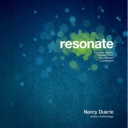It’s hard to really capture and hold the attention of a group, and pretty much impossible if your Powerpoint could double as a detailed written report. Duarte wants to help each of us be the best speaker we can be. And that means shaking us out of our heads and into the world of big ideas, and she’s gathered ideas, tips, quotes and examples from presenters as diverse as a marketer, an entrepreneur, a motivator, an activist, a preacher, a politician, a conductor and an artist to show us how. The opening chapter motivates the reader to do better presentations, and Duarte creates a compelling argument for building and developing speeches that resonate with people. You can make a difference. You can change the world.
She delves deep into story structure theory, ambitiously tying classic screenplay structure and Jungian psychology into how speeches should be structured. Some of this felt like a big stretch. I once worked at a public relations agency that promoted networking among professionals like lawyers and architects. Carl, the owner of the agency, would say that the goal for most people when speaking publicly was simply to get through the speech without being embarrassed. I think he was right. And I must say that it makes me giggle to think about some of those professionals, who simply don’t want to be embarrassed, to embrace Duarte’s principles.
Me: Jim, for your speech on the legal intricacies of back-dated stock options, remember, you are not the hero. The audience is the hero. In Star Wars-speak, you as the presenter are Yoda. Your audience is Luke Skywalker.
Jim: What?
Well, on second thought, maybe that advice does work even though it seems a little silly to think about yourself as Yoda at an industry conference. But the reality is that most presentations could benefit from the presenter thinking more about the audience and less about his or her performance.
And I’m not sure that Duarte herself would argue that every presentation can change the world. She concedes that some speeches and presentations are really reports and documents anyway. If that is what your boss wants, then deliver it. But know that it is not necessarily a persuasive presentation.
The motif woven throughout the book is that the use of contrast is what stimulates dramatic tension and attracts listeners. Duarte writes about three distinct types of contrast that can be inserted into a presentation: content, emotion and delivery. Content contrast is when the speaker compares what is to what could be. Emotional contrast is switching between analytical and emotional content. And delivery contrast is alternating between traditional, behind-the-podium and reading-the-slides communication and non-traditional delivery like polling the audience, using humor and minimizing slide use.
The second half of the book is strongest, as Duarte gets down to the brass tacks of pulling the presentation together. She rips back the curtain on how the great communicators illustrate their points by “panning for gold” among the dirt and detritus of personal experience, news stories, fiction and movies, and other industries or professions. And she makes the point clearly not only is this a lot of work (she talks about the weeks spent crafting words and visuals), but that it also makes the speaker vulnerable.
Resonate is a book for those who are serious about increasing their skills of persuasion and willing to put in the time and energy (and let’s be honest, the potential for embarrassment) to approaching a presentation as an opportunity to change minds. It is not a book for how to present all sides of an argument in an academic or government environment or a book on how many words each bullet should contain. But it is a tool that I will bring down from the bookshelf again and again. Particularly when I am looking to write or deliver a speech that persuades listeners to a certain point of view.
Details
Resonate: Present Visual Stories that Transform Audiences
Nancy Duarte
John Wiley & Sons, Inc., 2010: 250 pages, $29.95





Thank you for your thoughtful review, Lynn!
Nancy, I’m honored you stopped by to check out my review. Resonance gave me some great ideas about using contrast that I incorporated into the last speech I wrote…to great reviews!